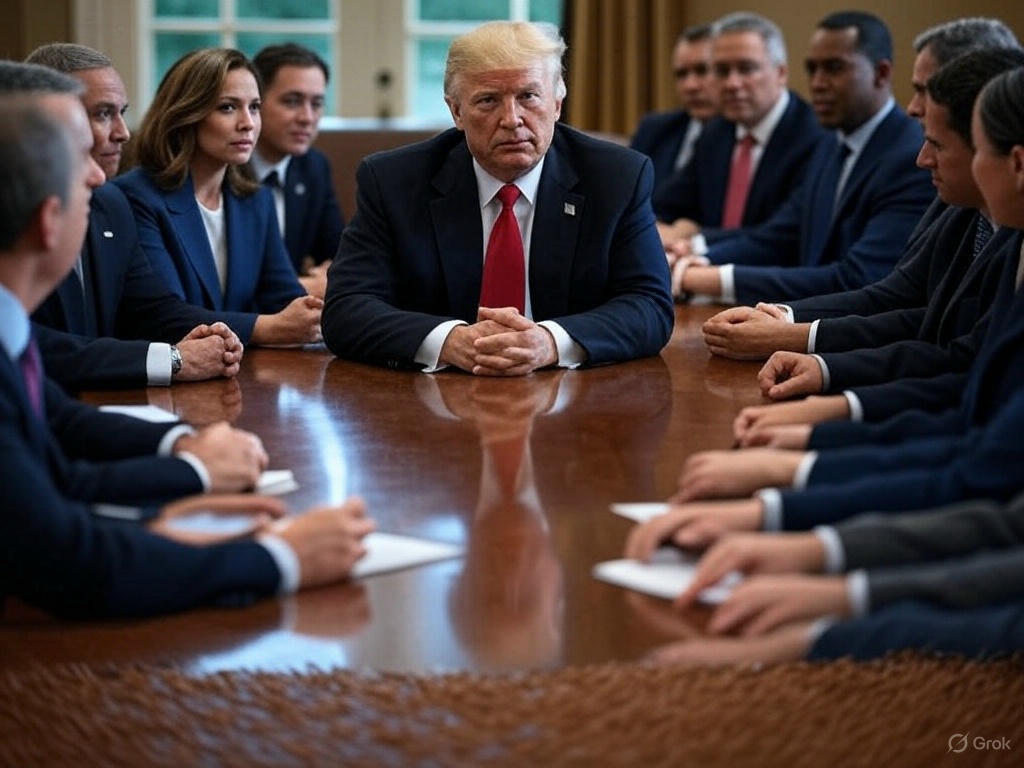The Trump administration is exploring a significant policy initiative to address declining US fertility rates: a potential $5,000 “baby bonus” for new mothers. This proposal is part of a broader push towards pronatalist policies designed to encourage Americans to have more children, amidst concerns that current trends could have profound economic and social consequences. The United States is grappling with fertility rates that have fallen to historically low levels, prompting a search for effective solutions.
The Crisis of Declining US Fertility Rates
The United States is facing a notable decline in fertility rates, a trend that has raised alarms among policymakers and demographers. In 2023, the total fertility rate in America fell to 1.62 births per woman, a 2% decrease from the previous year and the lowest rate recorded since the 1930s. This figure is significantly below the replacement rate of 2.1 births per woman, which is the level needed to maintain a stable population without relying on immigration.
Federal data indicates that the number of US births in 2023 was the lowest in 44 years, continuing a downward trend observed across multiple administrations. This decline spans various ethnic backgrounds and geographic regions, pointing to deep-rooted societal and economic factors.
Demographic Patterns of the Decline
Demographic Patterns of the Decline
The declining birth rate has affected different age groups unevenly, with younger women experiencing more pronounced decreases. From 2022 to 2023, birth rates for women in their early to mid-20s dropped by 4%, to 55.4 births per 1,000 women. Interestingly, women in their mid-to-late 30s are now having children at rates similar to those in their early to mid-20s, with 35-39 year olds recording 54.7 births per 1,000 women. This convergence reflects the increasing trend of delayed childbearing. Conversely, birth rates among women in their 40s remained stable during this period, suggesting that while fewer women are having children overall, those who delay childbearing are increasingly likely to pursue parenthood later in life.
Factors Driving the Fertility Decline
Factors Driving the Fertility Decline
A complex interplay of social, economic, and cultural factors drives the falling fertility rates in the United States.
- Economic Pressures: Financial considerations play a significant role in family planning decisions. High costs associated with housing, childcare, and education create substantial barriers to family formation and expansion. The average cost of raising a child to age 17 is estimated to be over $310,000 for a middle-income family. For many, the economic realities simply don’t favor having children, or as many children as previous generations.
- Delayed Marriage and Childbearing: The increasing prioritization of career development among women is another major factor. Women are marrying and having children later in life as they pursue education and establish careers. This delay has demographic and medical implications, shortening the reproductive window and potentially contributing to fertility challenges for those who postpone parenthood.
- Social Norms: Changing social norms and attitudes also play a role, with some couples choosing smaller families or child-free lifestyles.
- Uncertainty About the Future: Beyond immediate economic concerns, a growing sense of uncertainty about the future influence’s family planning. Economic volatility, political polarization, climate change concerns, and shifting global dynamics contribute to this uncertainty, making some potential parents question the desirability of having children.
- Other Factors: Additional contributing factors include health issues like rising obesity and reproductive health problems, as well as increased access to and use of contraception and family planning options, which give women more control over their reproductive choices.
The Proposed $5,000 Baby Bonus
The Proposed $5,000 Baby Bonus
To address these declining fertility rates, the Trump administration is considering a one-time $5,000 payment to American mothers after childbirth. The aim of this “baby bonus” is to offset the immediate costs associated with having a child and incentivize higher birth rates.
The bonus could be structured as a direct cash payment or a supplement to the existing child tax credit, although specific details are still under discussion. President Trump has expressed support for the idea, calling it “a good idea”. However, the proposal requires congressional approval, and no final decision or timeline has been confirmed.
Related Pronatalist Policy Proposals
The $5,000 baby bonus is one of several pronatalist policies being considered by the Trump administration. Other proposals include:
- Menstrual Cycle Education: Government-funded programs to educate women about ovulation and fertility to aid conception.
- Fulbright Scholarship Reservation: Reserving a percentage of Fulbright scholarships for married or parenting applicants to incentivize family formation.
- National Medal of Motherhood: Honoring mothers with a large number of children.
- Expanded Child Tax Credits: Providing ongoing financial support for families raising children.
- IVF Access: Expanding access to and affordability of in vitro fertilization (IVF).
These proposals align with a broader pronatalist agenda advocated by figures like Vice President JD Vance and Elon Musk, who argue that increasing birth rates is crucial for economic stability and societal vitality.
Expert Opinions and Public Reactions
The proposed baby bonus has sparked debate among experts and the public.
- Support:
- Proponents, such as policy advocates like Emma Waters, argue that the bonus can address infertility and promote family values.
- Administration allies, including Vice President Vance and House Speaker Mike Johnson, have expressed support for the idea.
- Some within the pronatalist movement believe that the administration’s focus will prioritize fertility issues.
- Criticism:
- Critics argue that the $5,000 bonus is insufficient to offset the high cost of raising a child and is unlikely to significantly influence family planning decisions. The average cost of raising a child to age 17 is estimated to be substantial.
- Some question the scientific basis of proposals like menstrual cycle education.
- Concerns have been raised about the potential for such policies to exclude non-traditional families or prioritize certain demographics.
- Ethical questions surround government incentives for childbirth, including concerns about personal autonomy and whether these policies address the root causes of declining fertility, such as childcare access.
Public sentiment is mixed, with limited comprehensive polling data available. Some parents may welcome the financial relief, while others view it as inadequate compared to the overall costs of raising children.
International Perspectives
Several countries have implemented baby bonus schemes and other pronatalist policies to address declining fertility rates, with varying degrees of success.
- Singapore: Singapore’s Baby Bonus offers a significant financial incentive, but the country’s fertility rate remains low, suggesting that such bonuses may have limited long-term impact.
- Australia: Australia’s baby bonus led to a temporary increase in birth rates, although some argue that it primarily influenced the timing of births rather than the overall number.
- Switzerland: A baby bonus in Switzerland resulted in a short-term fertility increase, but the effect faded quickly.
- South Korea: Cash transfers in South Korea showed a positive effect on fertility rates, particularly for low-income families.
These international examples suggest that while financial incentives can play a role, addressing broader issues like childcare support, housing affordability, and work-life balance is crucial for achieving sustained increases in fertility rates.
Potential Impacts and Considerations
Potential Impacts and Considerations
The proposed baby bonus and related pronatalist policies have potential economic and social implications.
- Potential Benefits:
- Increased birth rates could lead to a larger workforce, which could ease the strain on social programs and boost economic growth.
- Proponents also argue that larger families can strengthen community ties and traditional values.
- Potential Drawbacks:
- The cost of the bonus program could strain federal budgets.
- There are concerns about equity, as policies favoring certain family structures may exclude others.
- Increased population growth could exacerbate environmental concerns.
- The financial incentive may not be sufficient to offset the substantial costs of raising a child.
- Ethical Considerations:
- Government incentives for childbirth raise ethical questions about personal autonomy and whether they represent an appropriate role for the government.
- There are concerns about potential coercion or pressure on women.
Conclusion The Trump administration’s consideration of a $5,000 baby bonus reflects a policy response to declining US fertility rates and the potential economic and social challenges they pose. While the proposal has garnered support, its effectiveness remains uncertain, given the complexity of factors influencing family formation decisions and the mixed results of similar policies in other countries. A comprehensive approach that combines financial incentives with broader support for families may be necessary to address this complex issue. As discussions continue, the debate will likely touch on fundamental questions about individual choice, economic priorities, and the role of government in shaping demographic trends.

